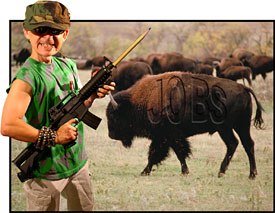Mark Simon chats with some of the industries top agents to find out how to work with agents and how they can help you find work.

A long time ago, before the days of talent agents, artists were often seen wandering aimlessly through the forests, sketching on tree bark. Its not that they didnt want to look for work, they just didnt know how and they didnt like doing it.
One day, a talent hunter spotted a green-crested pencil-finger and cautiously approached him. She told this creative being that she was not like other people. She cared about artists and had a talent for looking into the future.
That day brought about a great celebration in the land as artists could ignore the trappings of a job search, but still land good jobs. These agents could track a job through any landscape and foresee new trends.
This partnership continues today, but is not without some problems. Some of the artists have forgotten that the agents cant do all the work. The artists have to help them set the job traps.
Ive pulled together some of the greatest agents and managers known to man and have asked for them to share of their gifts. What is the future they see for creatives and artists in animation? And how can artists help the agents and managers in their quest?

My hunting party includes Shawn Walker from Natural Talent, Lisa Kaye from GreenLightJobs.com, Ellen Goldsmith-Vein from The Gotham Group, Matthew Ellis from the Metropolis Talent Agency and Garrett Hicks from Will Entertainment. They have taken me along on a trip to hunt both creative jobs and good artist clients.
No agent, manager or agency can survive a cold winter without talented and qualified artists, writers, producers and directors. We start with a decoy and by sounding an irresistible call for creatives, Work for artists and creatives. Work for artists and creatives. Our hunting stand is soon rushed by more creatives than could be represented.
I asked the members of my party how they thin the herd. Besides talent, what makes some people more hirable, and thus better clients, than others?
They all agreed that talent is the main thing they look for, but quickly added the need for professionalism and personality. Creatives need to be able to interview well. Not only in order to make a great impression in interviews, but as Shawn says, You need to show that if we send you out into the world and were attaching our name to you that you will be a good representation of our company.
Experience, shouts out Garrett. Im looking for someone with experience. If they have experience they will be more appealing to a broadcaster. Theres no learning curve. They should also have a great comic sensibility. Its not just about writing it out, its about being able to be in a room and shoot great, funny ideas around.

Attitude will often make one artist more preferable over someone who is more talent but more difficult to work with. As Matthew adds, A bad attitude is a great way to never get a call back from me, or from a possible employer. You dont want to give someone a reason not to hire you.
My hunting party also brought up the fact that they cant do it alone. They need help. They need their clients, the artists, help. Your help.
Agents do not clean or load hunting portfolios. That is up to the artist. Writers have to pull their own samples. Directors and producers have to build their own reels. These are the weapons agents need to do their job.
Managers, however will often work closely with creatives in development of their samples. However, the entire hunting party agrees when Garrett says, I let them know what people are looking for.
Reels and portfolios need to be professional and organized. Lisa explains, A diverse portfolio of creative work that includes samples of all areas of expertise, from animation, rendering, lighting, scripting, modeling, editing, etc. Desired formats for recruiters include a shot sheet and a breakdown of work so that it is easily identifiable. Any number of artists may have worked on any scene in a project. These shot sheets need to detail exactly what the artist did in each scene represented on a reel.
Hunting in the forests of representation, these agents are the first to come across trails of new trends. Experience also helps them forecast what may happen in the years to come.

Our fierce job hunters see many creatives making the same mistakes in the future. We all know hindsight is 20/20, but lets hope some of their foresight is also 20/20.
Lisa sees that many artists make the mistake of, stating that they are open for all types of work. This does not help market their work. Artists need to play to their strengths and know the market.
True, says Shawn. But more and more smaller studios are looking for one person to have multiple roles. Weve talked recently to a group who wanted just one or two artists to shape the whole look of a feature. Fewer people means lower expenses for the production, even if those people are very well paid. The trick is to know your strengths and weaknesses. Some artists are spread too thin handling multiple jobs.
However, larger studios tend to hire people for very specific roles. A diverse portfolio will not work as well at a large studio as it will in smaller ones.
The relatively recent trend of posting samples and reels on the Internet will continue to be important. Matthew adds, When artists have personal website portfolios, its a good calling card and a good place for me to refer possible employers to take a quick look at what someone has to offer.

Lisa agrees. The ability to view online portfolios of applicants and candidates is important and saves time, as does the ability to interview through enhanced technology.
The look of upcoming productions may continue to change, according to Ellen, Cool, innovative and interesting art styles will continue to emerge and become key ingredients to successful shows and movies. It looks like the development doors have opened for a new look. Speaking with John Solomon, exec producer in the Disney TV Animation Shorts Program, even the stalwart look of Disney is in the process of changing to take advantage of new creative talent.
But will animation writers be taken more seriously? Yes, as Ellen continues, Animation writers will continue to gain prominence in the live-action film and television business.
But Garrett cautions new writers. Its hard to break in as a first-time writer in animation. There are a lot of people who have been working in primetime who are now working in animation and there are just not that many jobs there anymore. Its harder because theres more experienced competition.
Hunting with styles and prominence is great, but what about the money. Are fees going up or down? Yes, state our fierce hunters.
The number of companies getting into the feature animation business helps keep rates up. Lisa told me, The salary ranges have increased over the past year as the job market continues to heat up.

Matthew sees rates migrating in a different direction, I see the industry improving in terms of an artist becoming more of a partner with production companies. And, in turn, taking less upfront, but participating in a projects success from a profit standpoint more than in the past.
Shawn was looking the other way while saying, It seems to be staying status-quo. There havent been any drastic changes, but I dont see it growing upwards either. It depends on the client.
What seems to be consistent is that the best and most amenable talent makes a lot of money from the biggest studios.
Fire up that laser scope, zero in on the job you want and load your gun with great samples in an organized fashion and then hand your gun to one of these amazing agents. Their sharp shooting will have you working in no time.
Mark Simon is an award-winning animation producer, storyboard artist and lecturer who is also the author of what could be considered promotional items, Facial Expressions: A Visual Reference for Artists, Producing Independent 2D Character Animation and Storyboards: Motion in Art. He can be found lurking around at www.FunnyToons.tv and may be reached at MarkSimonBooks@yahoo.com. Marks books may be found and purchased online at www.MarkSimonBooks.com.







